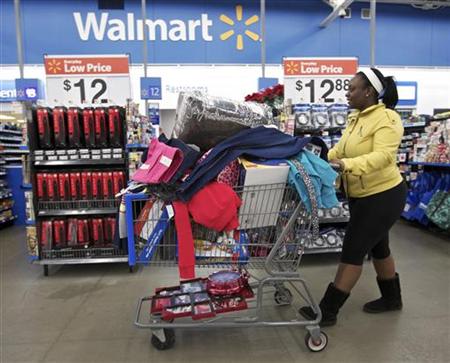
Wal-Mart,
the largest private employer in the United States and the world's
largest retailer, also said on Tuesday it plans to hire 100,000 newly
discharged veterans over the next five years, at a time when the U.S. unemployment rate is at 7.8 percent.
The moves come as the U.S.
economy continues to grow slowly 3-1/2 years after the end of a severe
recession. An average of $5 billion a year in spending is a drop in the
bucket for the $15 trillion U.S. economy, and the question is how many other retailers could do the same.
Terry Lundgren, chief executive of Macy's Inc and until this month the chairman of the National Retail Federation, told Reuters that Wal-Mart's plans to buy American were good but that cost would still be an issue.
"We would all love
to do that, the customer will not pay more," Lundgren told Reuters on
the sidelines of an NRF event where Wal-Mart presented its plans.
The moves received a cool reception from critics who claimed Wal-Mart
does not pay its workers enough and slammed the retailer for selling
too many goods made in lower-cost countries like China. The company is
also under pressure over its sourcing practices, particularly after a
deadly fire at a Bangladesh factory that made Wal-Mart clothes.
But Walmart's U.S. unit says about two-thirds of the goods it buys for its stores are made, sourced from or grown in the United States,
citing data from its suppliers. It has previously run "Made in America"
campaigns, and in the early 1990s it was criticized for promoting
foreign goods as domestically made.
Last year, 55 percent of Walmart
U.S. sales came from groceries like food and drinks as well as other
products that are typically sourced locally. Only 7 percent of Walmart U.S. sales were of apparel, jewelry and accessories, which retailers typically get from lower-cost countries.
To the extent Wal-Mart
buys more U.S.-made goods the company would have otherwise imported, it
would reflect the recent shift in the U.S. commercial relationship with
the rest of the world.
Both economic output and net imports declined sharply
during the 2007-09 recession. While gross domestic product has
rebounded, net imports have not, a sign the United States is meeting
more demand for goods and services domestically.
The company said its Walmart
U.S. and Sam's Club warehouse chain will increase what they already buy
in the United States in categories like sporting goods, basic apparel,
storage containers, games and paper products.
Walmart U.S. Chief Executive Bill Simon laid out the spending and hiring plan at the National Retail Federation's annual conference in New York.
JOBS FOR VETERANS
Wal-Mart is not a member of the NRF, a major industry trade association that has promoted the importance of retail jobs in the United States. The NRF asserts that 25 percent of American jobs are supported by the retail industry.
Along that line,
the company said starting on Memorial Day in May, it plans to hire
100,000 U.S. veterans over five years, a move supported by First Lady Michelle Obama.
"We've developed a national paralysis that's driven by
all of us waiting for someone else to do something," Simon said in
prepared remarks for the NRF. "But if we're waiting on government, we're
waiting on a process that can't act with the same speed as business."Veterans' issues are of personal interest to Simon, who served 25 years in the U.S. Navy and Navy Reserve. The company said it will offer a job to any honorably discharged veteran in the first year after active duty.
Depending on the time of year, there are anywhere from 15,000 to 50,000 job postings at Walmart. The company said it promotes about 170,000 people each year to jobs with more responsibility and higher pay.
About 75 percent of
its store management started as hourly associates, and now earn an
average of $50,000 to $170,000 a year. The highest earning store manager
last year made more than $250,000. Wal-Mart has repeatedly claimed its pay and benefits are in the top half of the retail industry.
Starting wages for Walmart U.S. store employees vary by market. Simon noted that in his first job as a dishwasher in a restaurant, he made $2.10 an hour.
Walmart
U.S. also said it would give part-time workers the first shot at
full-time positions. It also plans to make scheduling more transparent,
giving part-time workers the ability to choose more of their own hours.
Simon had barely finished speaking at the NRF event before critics responded to the new spending and hiring plan.
"Retailers like Walmart
could provide the nation with a much needed economic boost by paying
higher wages and providing stable scheduling - while still remaining
profitable and continuing to offer low prices," Stuart Appelbaum,
president of the Retail, Wholesale and Department Store Union, said in a
statement. "By part-timing their workforce, they're hurting both
workers and our economy by fueling underemployment."
Sales for Walmart
U.S. rose 1.5 percent to $264.19 billion in fiscal 2012, which ended in
February 2012, and accounted for 59.5 percent of the company's total
sales.
NO MENTION OF GUNS
One issue Simon did
not discuss was the retailer's position on guns, a hot topic since the
massacre at a Newtown, Connecticut elementary school last month. Wal-Mart is the nation's largest gun retailer.
Gun-control advocates rallied on Tuesday outside a store just eight miles from Sandy Hook Elementary School, where 20 children and six educators were killed on December 14.
The retailer
canceled a series of media interviews with Simon after his NRF speech,
including one with Reuters. Some media outlets claimed the cancellation
was due to his reluctance to discuss the gun issue. A spokesman declined
to give a reason.
Walmart shares rose 0.5 percent to $68.64 in mid-day trading, while the S&P retail index rose 0.6 percent.

No comments:
Post a Comment